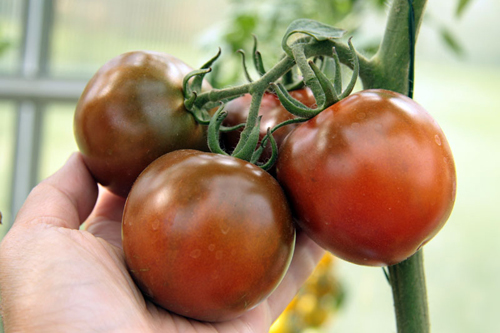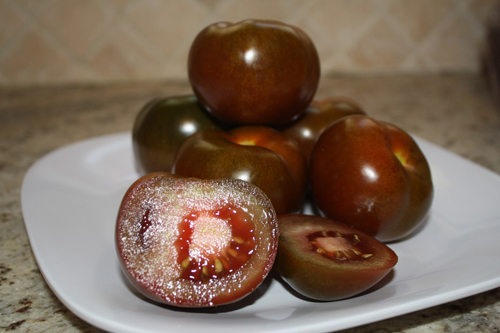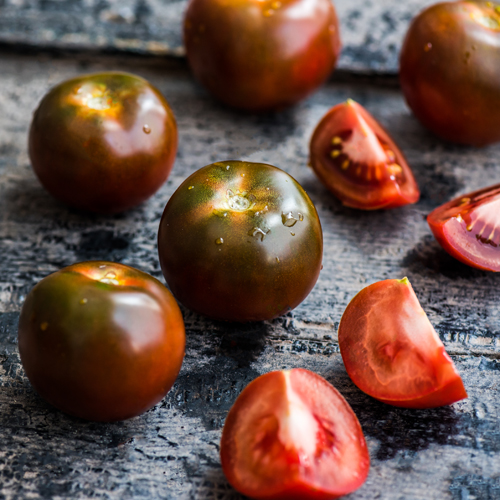Tomato variety Kumato (F1)
Tomatoes with an unusual black skin color, which until recently seemed to be a real exotic, are increasingly found in an ordinary garden bed. And despite the fact that a wide selection of black-fruited varieties is available for gardeners, there is one coveted variety, shrouded in such a veil of secrecy that it is rather difficult to break through it. And the name is the same mysterious - Kumato. Moreover, the name is a trade brand patented in 2006, owned by the Swiss company Syngenta. But in the American and Canadian markets, this vegetable is known as Rosso Bruno. The original name is Olmeca, the variety received in Spain, where it was born in 1970. Its creator, Luis Ortego, while touring the fields cultivated by his family near Almeria, drew attention to the fact that tomatoes, which received the least amount of water, had a completely different color, but at the same time had a rich, bright taste. The young man set himself the task of creating a variety that would match the color and taste of these fruits, and he achieved success.

Syngenta bought the rights to a successful novelty and immediately made the culture a so-called "club variety". This means that for ordinary vegetable growers, the seed will be inaccessible. Now only producers specially selected and licensed by a Swiss company can grow the senior tomato, but only Syngenta has the right to sell seed. Therefore, if Russian gardeners can get acquainted with such a popular view, it will only be in the supermarket, purchasing neatly packaged tomatoes. Of course, Kumato is not listed in the State Register of Breeding Achievements of Russia. The originators are positioning this tomato as a hybrid, therefore, in the hope of protecting the crop from counterfeiting, they warn that plants grown from the collected seeds will not inherit their parental characteristics.
Well, what about our tomato growers? They, of course, were not taken aback, and, having acquired the coveted product in the supermarket, they immediately began to experiment with the collected planting material. And it is so fortunate that Kumato seeds are already being distributed by some amateurs under the banner "Author's Seeds". But most often ordinary members of the forum share the seed among themselves, who describe the incredible properties of this black-fruited variety.
Description
The plant is indeterminate, 180 - 200 cm high. In the open field, the growth of a tomato is more modest - about 1 meter. Many describe the plant as powerful, with a sturdy stem, but compact, as the shoot-forming ability is weak. Leaves are healthy, succulent, green, normal type, medium size, slightly wrinkled. The first fruit cluster is formed above 10-11 leaves. Further, as befits indents, inflorescences are laid every 2 - 3 leaves. Moreover, the brushes are tied without gaps. Each cluster has 3 to 7 flowers, but gardeners have noticed that, as a rule, more than 4 - 5 fruits do not ripen in them. The peduncle is articulated.

Kumato fruits are very hard, thick-walled, small, weighing 80 - 120 grams, 5 - 6 cm in diameter. The shape is smooth, round. Unripe tomato is green. When ripe, it can turn red-brown or almost purple. The pulp of the variety is dense, fleshy, low-liquid, but juicy, three- or four-chambered, there are enough seeds. On the cut, the flesh is greenish-brown, with a lighter red tint in the very center. Tomatoes are rich in potassium, magnesium, vitamins, A and C. They contain no saturated fat and cholesterol, the calorie content of 150 grams of the product is only 31 kcal. The aroma is either very weak or completely absent. But the taste of real tomatoes grown under special conditions is simply unforgettable - sweet (sweeter than other varieties), with a slightly sour, contrasting note. This combination creates a unique and vibrant taste sensation.The sweet taste is associated with a higher fructose content and optimal temperature conditions that can only be achieved with industrial cultivation. That is why some gardeners are not delighted with the taste of the tomato grown in the garden. Another big drawback of a home-grown vegetable is that the skin is too thick.
Variety characteristics
- In terms of ripening, the Kumato hybrid belongs to the early maturing, which fits well into the framework of industrial cultivation. Domestic gardeners also talk about an early or mid-early harvest;
- the yield level is average - about 2.5 kg per bush. But, as noted, rates are highly dependent on climate and care;
- according to the originators, the vegetable grows well even on salty soils;
- fruiting in closed ground lasts until frost begins;
- tomatoes are perfectly ripened at home;
- immunity is very good, during cultivation the variety showed resistance to late blight and cladosporium;
- the dense skin protects the fruits from cracking, even during the period of prolonged rains;

- Kumato's adaptability is good, he is not afraid of heat and cold snaps, he sets fruits equally stably both in the open and in the closed ground;
- transportability is excellent. Keeping quality too, gardeners note that the crop can be stored for more than a month. But the originators do not recommend such a long shelf life, especially in the refrigerator. According to them, tomatoes are perfectly stored indoors for up to two weeks. And in the refrigerator they very quickly lose their sweetness and lose their unique taste;
- the way of use is universal. Tomatoes are good in their natural form, suitable for cooking various dishes (for example, Italian pasta, vegetable soup). The housewives highly appreciated the pickling qualities of the variety and the suitability for canning whole-fruit.
Agrotechnics
It is, of course, better to grow a valuable hybrid in a seedling way. The sowing period is the beginning of March, be sure to process the seeds before the procedure. The age of seedlings ready for transplantation is 60 - 65 days. Plants are usually transplanted into the greenhouse in mid-May, in open ground - in early June. The recommended planting density is 4 pieces per 1 square meter. After planting, the bush is tied to a trellis or support. Form a culture of 2 or 3 stems. The care is very simple. You just need to prevent overdrying the soil, apply top dressing on time and keep the garden clean.
Syngenta closely monitors the cultivation of the hybrid and keeps track of the number of tomato seeds produced. Currently, licensed agricultural firms and companies cultivate varieties with similar names - Mini Kumato, Cherry Kumato. And ordinary gardeners manage to grow a hybrid with an unusual color, for example, striped.
Syngenta has created such an aura of mystery for its promoted brand that this hybrid can only be compared in popularity with famous Hollywood stars. There are groups of fans of this vegetable all over the world, it has a Facebook page, many culinary sites are vying with each other about the superiority of this variety over others. Not to mention the fact that only a select few are allowed to grow the culture. This popularity has brought huge profits to the Swiss company. Despite the warning about Kumato's belonging to hybrids, many tomato growers, and all over the world, are actively sharing with each other joyful messages that plants grown from self-collected seeds are no different from their parents. They have excellent immunity, low branching, facilitating maintenance, and normal yield. Of the shortcomings of tomato, a very thick skin is often called (but it perfectly protects the fruit from cracking in a jar) and taste that can hardly be called unique.








